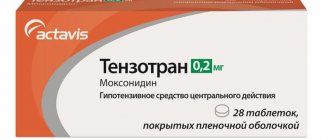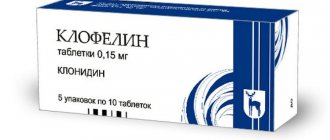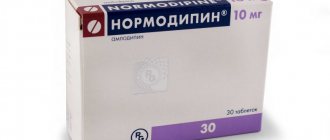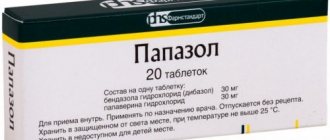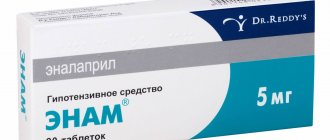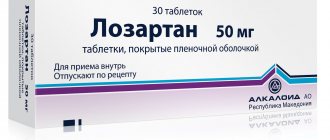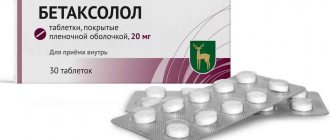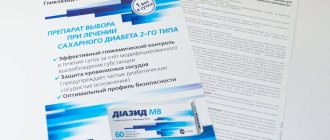The effective drug Indap belongs to the group of non-thiazide diuretics with moderate activity of the sulfonamide class. The drug is prescribed to normalize blood pressure in hypertension. Indap tablets relieve swelling, remove excess water from the body, maintain the balance of nutrients, dilate blood vessels, and reduce tone. The medication is prescribed by the attending physician. You can buy the drug at any pharmacy upon presentation of a prescription sheet. The price of Indap tablets is lower than that of thiazide-like drugs of similar action.
Pharmacodynamics and pharmacokinetics
The main component is indapamide . The drug has a hypotensive effect . The pharmacological properties of the drug Indap are similar to thiazide diuretics; the principle of action is based on a violation of the reabsorption of sodium ions in the cortical region in the loop of Henle. The drug increases the excretion of sodium, chlorine, magnesium, and potassium ions from the body in the urine. The drug selectively blocks “slow” calcium channels, reduces peripheral vascular resistance, and increases the elasticity of vascular walls.
Indap does not affect the level of lipids in the blood plasma or carbohydrate metabolism, which is important in the treatment of patients with diabetes mellitus . Under the influence of indap, the sensitivity of the vascular wall to the action of angiotensin-2 and norepinephrine .
The drug stimulates the production of prostacyclin PgI2, PgE2, reduces the synthesis of stable oxygen and free radicals. High dosages of the drug cause increased diuresis, but do not affect the degree of drop in blood pressure.
With repeated, stable use, the effectiveness of the drug is registered in the second week.
Contraindications
The drug is contraindicated in cases of hypokalemia , anuria , pathologies of the renal system, severe liver damage, and intolerance to Indapamide .
The drug is not prescribed for decompensated diabetes mellitus with ketoacidosis , acute cerebral circulatory disorders, galactosemia , lactose intolerance, impaired absorption of galactose or glucose.
For ascites, moderate renal/liver failure, water-electrolyte imbalance, hyponetremia, prolongation of the QT interval, for CHF, coronary heart disease, hyperuricemia, breastfeeding, hyperparathyroidism, urate nephrolithiasis, gout, Indap is prescribed with caution.
Features of good stagnation
Patients with impaired liver function
In patients with impaired liver function, congestion of thiazide-like diuretics can cause hepatic encephalopathy, especially if the electrolyte balance is disturbed. It is important to avoid taking diuretics at this time.
Light sensitivity
It was reported about episodes of light sensitivity reactions in patients who took thiazide and thiazide-like diuretics (section “Adverse reactions”). In case of such reactions, treatment with diuretics is recommended. If there is a need for re-administered diuretics, it is necessary to protect the spill from the sun or from ultraviolet radiation.
Additional speeches
The drug is lactose-absorbent and should not be prescribed to patients with congenital galactose intolerance, glucose-galactose malabsorption syndrome, or Lapp lactase deficiency.
Water and electrolyte balance
Sodium
It is necessary to control the level of sodium in the blood plasma before the start of the course and then - regularly during the hour of the course. Any diuretic can cause hyponatremia, which may have serious consequences. A decrease in blood plasma sodium levels may be asymptomatic at first, so regular monitoring is necessary. Monitoring of sodium levels is carried out more often in patients with summer age and in patients with liver cirrosis.
Potassium
A decrease in the level of potassium in blood plasma due to hypokalemia is the main risk in the treatment of thiazide and thiazide-like diuretics. The development of hypokalemia (< 3.4 mmol/l) must be preceded in certain categories of high-risk patients, such as patients with advanced age, patients with poor nutritional status, and/or patients Those who take a large number of medications, patients with liver cirrosis, which is accompanied by swelling and ascites, patients with ischemic heart disease and patients with heart failure. In such episodes, hypokalemia promotes cardiotoxicity of cardiac glycosides and the risk of arrhythmias.
Patients who may have a prolonged QT interval due to congenital or iatrogenic origin are also considered to be in the risk group. Hypokalemia, as well as bradycardia, can lead to the development of severe disturbances of the heart rhythm, including paroxysmal scapular tachycardia of the “burst” type, which can lead to death.
In all serious illnesses, frequent monitoring of blood potassium levels is necessary. The first analysis must be completed during the 1st year of treatment. If hypokalemia is detected, it should be corrected.
Calcium
Thiazide and thiazide-like diuretics can alter the excretion of calcium from the bloodstream and lead to a slight and temporary increase in the level of calcium in blood plasma. Hypercalcemia may be an inheritance of previously undiagnosed hyperparathyroidism. In this case, it is necessary to examine and verify the function of the parathyroid glands.
Blood glucose
In patients with diabetes, it is important to control blood glucose, especially if hypokalemia is evident.
Sechowa acid
Patients with elevated levels of sechoic acid may experience a tendency to increase the number of gout attacks.
Function of drugs and diuretics
Thiazide and thiazide-like diuretics are the most effective if the function is not impaired or if the impairment is insignificant (blood plasma creatinine < 25 mg/l, then 220 mmol/l in adults). In summer age patients, the level of creatinine in blood plasma is related to age, body weight and status. Hypovolemia, associated with the loss of water and sodium due to the stagnation of diuretics, causes a decrease in glomerular filtration. This can lead to an increase in blood levels and creatinine. Such transient functional nitric deficiency does not interfere with the normal functioning of nirk, but may aggravate the original nirk deficiency.
In athletes
Indapamide may cause a positive reaction during doping control
Suspension during pregnancy or breastfeeding.
Vaginism
There is no need to use diuretics for vaginal women and they should not be used to treat physiological vaginal damage. Diuretics can lead to fetoplacental ischemia with the risk of inhibiting fetal growth.
Anniversary breastfeeding
In the period of breastfeeding, indapamide is not recommended due to evidence of high penetration into breast milk.
This is due to the fluidity of the reaction during treatment with vehicles or other mechanisms.
The drug does not act on the effect, but sometimes causes undesirable reactions (section “Adverse reactions”), including symptoms associated with decreased arterial pressure, especially on the scalp and sometimes stagnation bath in a combination with another antihypertensive agent, The originality of the car or operation with other mechanisms may be damaged.
Side effects
The severity of side effects largely depends on the dosage of the drug.
Digestive system: dyspepsia , stool disorders, epigastric pain, nausea, dry mouth, vomiting, gastralgia, appetite disturbances.
Nervous system: dizziness, nervousness, asthenia , headaches, vertigo, drowsiness, dizziness, depression, insomnia, agitation, irritability, anxiety, tension, nervousness, lethargy, lethargy , asthenia, increased fatigue, malaise, spasm of muscle fibers.
Sense organs: visual disturbances, conjunctivitis .
Respiratory system: pharyngitis , cough, rhinitis.
Cardiovascular system: palpitations, arrhythmias , hypokalemia, orthostatic hypotension .
Urinary system: polyuria, nocturia , frequent urinary system infections.
Flu-like syndrome , back pain, infectious lesions, chest pain, increased sweating, rhinorrhea, libido/potency disorders, paresthesia in the extremities, weight loss, allergies, hyponatremia, hyperglycemia, hyperuricemia, hypochloremia, glucosuria, hypercreatininemia, are also recorded . hypochloremia, increased urea nitrogen levels, hypercalcemia.
Indap, instructions for use (Method and dosage)
The medicine is taken in the morning, orally.
The initial dosage for arterial hypertension is 1.25-2.5 mg per day (non-extended forms of the drug), or 1.5 mg of the prolonged form of the drug per day.
If full effectiveness is not achieved, after 4-8 weeks a drug with a different mechanism of action is added to the treatment regimen.
According to the instructions for use, increasing the dosage is considered inappropriate due to an increase in the severity of side effects and failure to achieve the target blood pressure level.
Release form and composition
Available in capsules: size No. 4, hard gelatin, with a blue cap and a white body; contents – white or almost white powder (can be a compressed column that disintegrates when pressed, or have pieces of mass in the composition) (10 pieces in a blister, 3 blisters in a cardboard box).
Active ingredient: indapamide, 1 capsule – 2.5 mg.
Auxiliary components: granulated microcrystalline cellulose, colloidal silicon dioxide, magnesium stearate, titanium dioxide, corn starch, gelatin, lactose monohydrate, indigo carmine dye.
Overdose
Manifested by disturbances in the functioning of the digestive system, respiratory depression, excessive drop in blood pressure, weakness, vomiting, fluid and electrolyte disturbances , nausea. In persons with cirrhosis of the liver, hepatic coma is recorded.
Timely symptomatic therapy, gastric lavage, and correction of water and electrolyte balance are required. A specific antidote has not been developed.
Overdose
Symptoms of overdose, first of all, may manifest water-electrolyte imbalance (hyponatremia, hypokalemia). Clinically possible: nausea, vomiting, arterial hypotension, nausea, drowsiness, confusion (vertigo), confusion, polyuria or oliguria right up to anuria (which is caused by hypovolemia yu).
The first steps of assistance include the introduction of the drug by the way of washing the vulva and/or the recognition of active vugille from further updating the water-electrolyte balance in the hospital’s urine.
Interaction
Indap increases the level of lithium ions in the blood, reducing its excretion through the renal system. Lithium can have a pronounced nephrotoxic effect . Due to dehydration of the body, there is an increased damaging effect on the kidneys when using iodine-containing contrast medications. Before carrying out the procedures, it is recommended to restore the loss of water. Indap reduces the effect of indirect anticoagulants .
When taking non-depolarizing muscle relaxants, there is an increase in blockade during neuromuscular transmission. Laxatives, amphotericin B, tetracosactide, glucocorticosteroids , cardiac glycosides, thiazide, loop diuretics, saluretics increase the likelihood of developing hypokalemia. The risk of digitalis intoxication increases with the simultaneous administration of cardiac glycosides. Taking a calcium drug causes hypercalcemia, Metformin causes lactic acidosis.
Pentamidine, sultopride, erythromycin, astemizole, vincamine, terfenadine , disopyramide, quinidine, antiarrhythmic drugs, bretylium tosylate, amiodarone, sotalol due to a synergistic effect can lead to the development of arrhythmias. Adrenergic stimulants, teracosactide, glucocorticosteroids reduce the severity of the hypotensive effect, baclofen - on the contrary. The risk of developing acute renal failure and arterial hypotension increases significantly with the use of ACE inhibitors.
Orthostatic hypotension may occur when antipsychotics and tricyclic/imipramine antidepressants are prescribed. Hypercreatininemia has been reported when taking cyclosporine .
Interactions with other medicinal drugs and other types of interactions
Combinations not recommended
Lithium.
There may be an increase in the level of blood plasma and the appearance of symptoms of overdose, as with a salt-free diet (reduced excretion of blood plasma). If it is necessary to administer a diuretic, closely monitor blood plasma levels and adapt the dose of the drug.
Combinations that require caution
Drugs that can cause paroxysmal scapular tachycardia of the “piruet” type:
- antiarrhythmic drugs class Ia (quinidine, hydroquinidine, disopyramide);
- antiarrhythmic drugs class III (amiodarone, sotalol, dofetilide, ibutilide);
- types of antipsychotic drugs:
o phenothiazines (chlorpromazine, cyamemazine, levomepromazine, thioridazine, trifluoperazine);
o benzamide (amisulpride, sulpiride, sultopride, tiapride);
o butyrophenone (droperidol, haloperidol);
- Other medicinal products: bepridil, cisapride, diphemanil, internal erythromycin, halofantrine, mizolastine, pentamidine, sparfloxacin, moxifloxacin, internal vincamine.
When indapamide is taken with essential drugs, there is an increased risk of developing ventricular arrhythmias, associated with torsades de pointes
– paroxysmal scapular tachycardia of the “pirating” type (hypokalemia is a risk factor).
Before using such a combination, you should check the amount of potassium and adjust it if necessary. Monitor the clinical status of patients, plasma electrolytes and ECG. If hypokalemia is detected, it is recommended to prescribe medications that do not cause torsades de pointes.
Non-steroidal anti-inflammatory drugs (for systemic use), including selective cyclooxygenase 2 inhibitors, high doses of salicylates (≥ 3 g/dose):
- may reverse the antihypertensive effect of indapamide;
- In anhydrous patients there is an increased risk of developing acute nitric deficiency (through decreased glomerular filtration). Before starting the bath, it is necessary to restore the water balance and check the function of the liquid.
ACE inhibitors.
It is possible that arterial hypotension and/or acute hypotension may occur in patients with low sodium levels (especially in patients with nitric artery stenosis).
Arterial hypertension
. If the prior use of a diuretic caused a decrease in sodium level, it is necessary to start taking a diuretic 3 days before the start of treatment with an angiotensin converting enzyme (ACE) inhibitor and then, when necessary. Renew therapy with a diuretic or start taking an ACE inhibitor at a low initial dose with further progressive progress.
For persistent heart failure
Treatment with an ACE inhibitor should be started at a minimal dose, possibly after reducing the dose of a previously prescribed diuretic to remove potassium.
Who knows?
it is necessary to monitor the function of the blood (plasma creatinine) through the first intensive treatment with an ACE inhibitor.
Drugs that can cause hypokalemia: glucose, mineralocorticoids (for systemic use), amphotericin B (intravenous), tetracosactide, carrier drugs that stimulate peristalsis –
promote the risk of hypokalemia (additive effect). It is necessary to control and, whenever necessary, correct potassium levels in blood plasma, with particular attention to one-hour therapy with cardiac glycosides. It is recommended to use transitory medications that do not stimulate peristalsis.
Cardiac glycosides.
The presence of hypokalemia indicates the cardiotoxicity of cardiac glycosides. Next, monitor potassium in blood plasma, ECG control and, if necessary, correct treatment.
Baclofen
enhances the antihypertensive effect of the drug. At the beginning of therapy, it is necessary to restore the patient’s water-electrolyte balance and control the function of the patient.
Combinations that require respect
Potassium-sparing diuretics (amiloride, spironolactone, triamterene).
Yakshcho ISNUTSHILNITH INTERNALLY COMBINATSIA, there is no way of vinikennya gipocal -miMіy (especially for ailments on the zurovye aboat of the nicrum of disadvantage), an abdomaliym. Then monitor the level of potassium in blood plasma, ECG control and adjust therapy when necessary.
Metformin.
There is an increasing risk of lactic acidosis due to the development of functional nitric deficiency following the use of diuretics, especially loop diuretics. There is no need to prescribe metformin if plasma creatinine levels exceed 15 mg/l (135 µmol/l) in men and 12 mg/l (110 µmol/l) in women.
Iodine contrast agents.
In cases of dehydration caused by taking diuretics, the risk of developing acute nitric deficiency increases, especially when high doses of iodine contrast agents are ingested. It is necessary to restore the fluid balance before iodine contrast is recognized.
Imipramino-like antidepressants, neuroleptics.
Strengthening the antihypertensive effect and reducing the development of orthostatic hypotension due to the additive effect.
Calcium salts.
Hypercalcemia may be due to decreased calcium elimination by hydroxide.
Cyclosporine, tacrolimus.
The risk of elevation of creatinine in blood plasma without adding to the level of circulating cyclosporine is due to the presence of a decrease in the level of water/sodium.
Corticosteroids, tetracosactide (systemic).
Changes in the antihypertensive action of indapamide due to the retention of water and sodium ions under the infusion of corticosteroids.
special instructions
For patients with hyperaldosteronism , when taking laxatives or cardiac glycosides, regular monitoring of potassium and creatinine levels is strongly recommended. Systematic use of the drug Indap requires monitoring the level of magnesium, sodium, potassium ions in the blood plasma, residual nitrogen, uric acid, sugar due to the risk of developing electrolyte disturbances. More careful monitoring is indicated for patients suffering from liver cirrhosis , ascites due to the high risk of developing metabolic alkalosis , increased severity of encephalopathy, CHF, and ischemic heart disease. Patients with a high QT interval on the ECG are at increased risk. It is necessary to analyze changes in potassium levels in the body during the first week of therapy. In previously undiagnosed hyperparathyroidism, calcium levels may increase with the use of the drug. For patients with diabetes mellitus, it is extremely important to control glucose levels when taking Indap, especially with severe hypokalemia. A decrease in glomerular filtration and the development of acute renal failure is possible as a result of significant dehydration. At the beginning of treatment, it is necessary to carefully monitor kidney function and, if necessary, compensate for fluid loss. While using the drug, a positive doping test may be registered. Indap may cause an exacerbation of systemic lupus erythematosus . The safety and effectiveness of Indap in children has not been established.
Pharmacological properties of the drug Indap
Indapamide is a diuretic of moderate action, belongs to the group of non-thiazide sulfonamides, has an antihypertensive effect. The antihypertensive effect occurs only when blood pressure is initially elevated. Reduces the tone of smooth muscle tissue of the arteries, peripheral vascular resistance. It has a moderate saluretic and diuretic effect due to the blockade of reabsorption of sodium, chlorine, water and, to a lesser extent, potassium in the proximal tubules and the cortical segment of the distal tubules of the nephron. In therapeutic doses does not affect lipid and carbohydrate metabolism; does not increase the sensitivity of peripheral tissues to the action of insulin. After oral administration, it is quickly absorbed from the intestines. Bioavailability of the drug is 93%. The half-life is 16 hours. The drug is slowly eliminated, mainly by the kidneys, mainly in the form of metabolites. The antihypertensive effect develops during the first week with systematic use of the drug.
Analogs
Level 4 ATC code matches:
Chlorthalidone
Klopamide
Ravel SR
Indapamide
Arifon
There are a large number of analogues: Arifon , Vazopamide , Indapamide , Indapen , Indapres , Indiur , Lorvas , Ravel , Hemopamide .
Indapa price, where to buy
The price of Indapa in capsules of 2.5 mg in an amount of 30 pieces is about 105 rubles.
- Online pharmacies in RussiaRussia
- Online pharmacies in UkraineUkraine
- Online pharmacies in KazakhstanKazakhstan
ZdravCity
- Indap tab.
2.5 mg No. 30PRO.MED.CS Prague j.s. 111 rub. order - Indapamide tablets p.p.o. 2.5 mg 30 pcs. Polpharma Pharmaceutical plant S.A.
96 RUR order
- Indapamide Retard tablets p.p.o. prolonged action 1.5 mg 30 pcs. Ozon LLC
90 rub. order
- Indapamide Retard tablets p.p.o. prolonged action 1.5 mg 30 pcs. JSC Tatkhimfarmpreparaty
73 rub. order
- Indapamide tablets p.p.o. 2.5 mg 30 pcs. LLC HEMOFARM
81 RUR order
Pharmacy Dialogue
- Indapamide tablets 2.5 mg No. 30Biokhimik OJSC
25 rub. order
- Indapamide tablets 2.5 mg No. 30 Alsi Pharm
25 rub. order
- Indapamide (tablet p/o 2.5 mg No. 30) Teva
67 RUR order
- Indapamide retard-Teva (tab.p.pl/vol. 1.5 mg No. 30) Merckle GmbH
111 rub. order
- Indapamide retard tablets 1.5 mg No. 30 TCPP
63 RUR order
show more
Pharmacy24
- Indapamide-Astrapharm 2.5 mg No. 30 tablets TOV Astrapharm, Ukraine
42 UAH order - Indapen 2.5 mg No. 30 tablets Pharmaceutical plant "POLFARMA" S.A., Poland
78 UAH order
- Indapamide-Teva SR 1.5 mg No. 30 tablets Merkle GmbH, Nimechchina
93 UAH order
- Indapen SR 1.5 mg No. 30 tablets Pharmaceutical plant "POLFARMA" S.A., Poland
81 UAH order
- Indapamide 2.5 mg No. 30 tablets Hemofarm AD, Serbia
83 UAH order
PaniPharmacy
- Indap capsule Indap capsule. 2.5 mg No. 30, PRO.MED.CS Praha
117 UAH. order
- Indapamide SR tablets Indapamide SR 1.5 mg tab. No. 30 Poland, Pliva Krakow
82 UAH order
- Indapen SR tablets Indapen SR tablets. p/o 1.5 mg No. 30 Poland, Polpharma
92 UAH order
- Indapamide tablets Indapamide tablets. 2.5 mg No. 30 Serbia, Hemofarm
100 UAH order
- Indapamide tablets Indapamide-Astrapharm tablets. 2.5 mg No. 30 Ukraine, Astrapharm LLC
51 UAH order
show more

